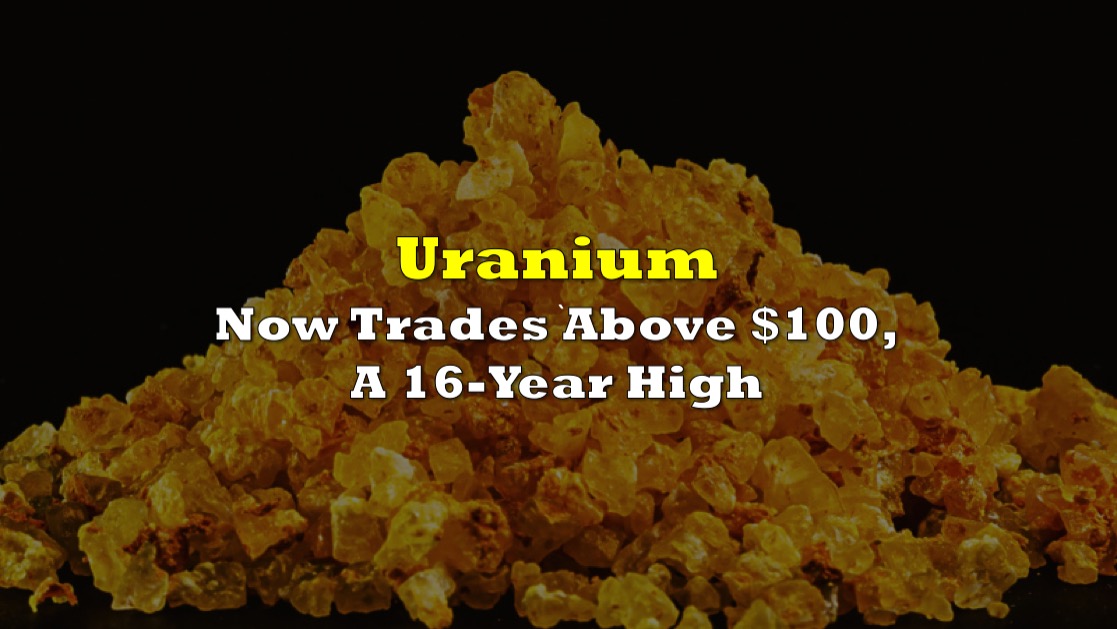Uranium trading prices have surged above $100 per pound, reaching their highest levels since late 2007, as demand for nuclear energy continues to rise globally. This remarkable uptrend is fueled by ambitious decarbonization goals and the commitment of the United States and 20 other nations to triple their nuclear power capacity by 2050.

China leads the charge in the nuclear energy push, with plans to construct 22 out of the 58 global reactors in development. Japan is also rekindling its nuclear ambitions, restarting projects to increase power output, and Finland recently marked the opening of Europe’s first new nuclear facility in 16 years.
In response to these developments, utilities have signed contracts for 160 million pounds of U3O8 in 2023, the highest volume since 2012. However, this surge in demand is met with increasing threats to the supply chain. Western utilities are voluntarily avoiding Russian uranium imports due to geopolitical concerns, and there are indications that the U.S. may move towards banning imports from the world’s top nuclear fuel producer.

Shortage in supply
The challenges in the uranium market are further compounded by miners struggling to meet the growing demand. Cameco, one of the world’s largest producers, is facing setbacks at key mines, prompting the company to consider purchasing additional uranium to fulfill customer obligations. Production disruptions in Niger and Kazakhstan have exacerbated the supply shortage, intensifying the competition for available uranium.
Jonathan Hinze, president of UxC, a market-data firm assessing uranium prices, notes, “Spot supplies appear to be extremely sparse these days.” Morgan Stanley analysts predict a bullish future for uranium prices, expecting them to reach $95 per pound by the second quarter of 2024, given the persistent supply-demand imbalance.
Cameco’s production challenges in 2023 and downgraded forecasts have played a pivotal role in the recent price rally. The company’s struggles are reflective of broader industry setbacks, including production issues at Kazatomprom in Kazakhstan and maintenance work in Niger by French nuclear-fuel company Orano.
The heightened competition for uranium has prompted financial buyers to reenter the market, with Sprott Physical Uranium Trust and Uranium Royalty actively acquiring substantial quantities. Sprott Physical Uranium Trust, which has amassed over 60 million pounds of U3O8 since its inception in 2021, began buying uranium again in September, and Uranium Royalty recently purchased 1 million pounds as an investment.

The rapid increase in prices has caught companies off guard, hindering their ability to adjust production plans promptly. Many miners are cautiously monitoring whether elevated prices will be sustained before committing to reopening mothballed sites or accelerating new projects.
The recent United Nations’ annual climate meeting (COP28) saw over 20 countries, including the U.S., pledging to triple nuclear energy capacity by 2050 as a crucial step towards achieving global net-zero emissions. With over 60 reactors under construction and another 110 planned worldwide, the nuclear energy sector is witnessing a resurgence.
As the industry anticipates sustained price increases, smaller uranium companies in the U.S., Australia, and Namibia are seizing the opportunity to restart operations and secure new customers. Tim Gitzel, Cameco’s chief executive, emphasizes the unprecedented nature of the current cycle, stating, “We’ve never been this early in the cycle with prices as high as they are today.” Analysts suggest that this momentum may lead to significant movement in new uranium mine projects in the coming months.
In conclusion, the uranium market is experiencing a dynamic phase, with prices reaching levels not seen in 16 years. The delicate balance between surging demand and supply challenges is reshaping the global landscape for nuclear energy, with the industry closely watching for sustained trends in the coming months.
Information for this story was found via The Wall Street Journal, Markets Insider, Numerco, and the sources mentioned within the article. The author has no securities or affiliations related to the organizations discussed. Not a recommendation to buy or sell. Always do additional research and consult a professional before purchasing a security. The author holds no licenses.









